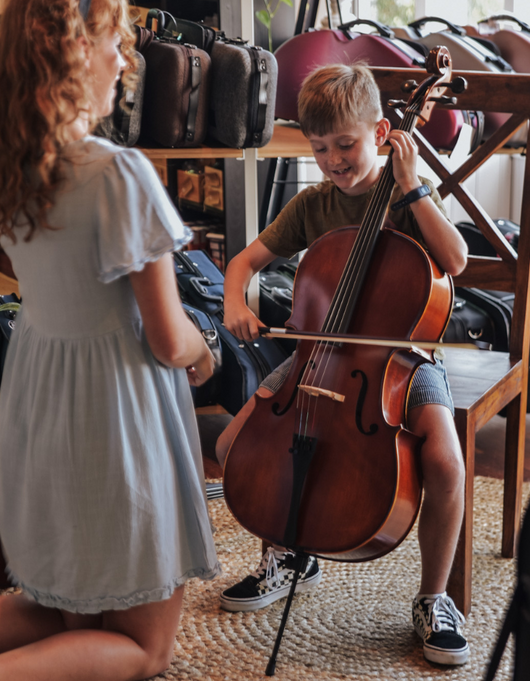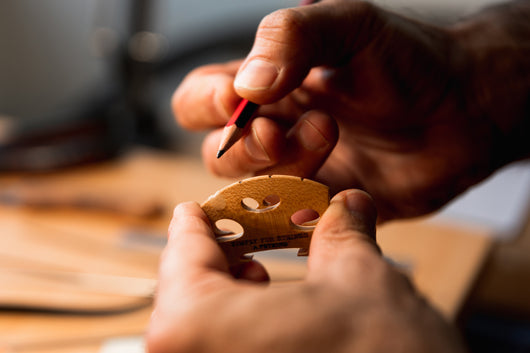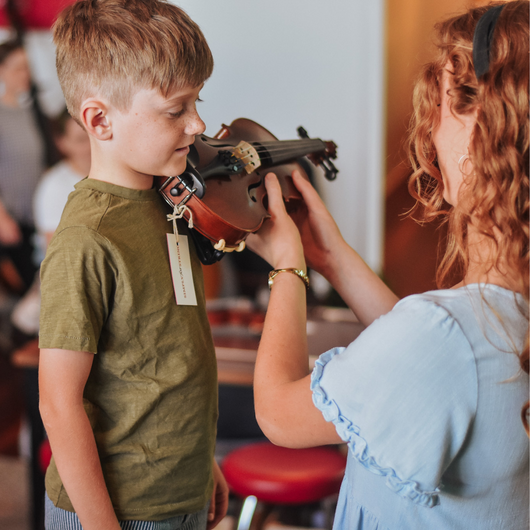If you've opened your case to find your instrument has loose strings, or the pegs have popped out, don't fret! You're not alone - we experience it ourselves every year at the Old Church as the weather changes.
As the humidity drops, and the air becomes very dry, all of the timber in your instrument (aka, the entire instrument!) gets the moisture sucked out of it. As your instrument is handcrafted using different timbres, they all expand and contract in different ways, which can cause the pegs to slip or tighten or seams to open. You might even feel a sudden drop in the playing height of your strings or find that your instrument sounds dull. Your bow may react to the dry weather too. You might find the bow hair is too tight or too loose while humidity levels are low.
We understand your instrument's reaction to dry weather can be a hassle when you're just trying to practice, so we've got some tips to help your instrument survive the dry weather spell!
With the change in the seasons (summer to autumn and through to winter), the temperature and humidity start to fluctuate and affect our instruments. Strings may no longer stay in tune and your instrument may sound a little different. As our instruments are made up of many different types of wood that expand and contract at different rates, the cooler months can affect our instrument in many ways. Here are a few simple tips to help your instrument survive winter.
Quick steps
1. Invest in a humidifier. A humidifier will gradually release moisture into the surrounding air, helping to keep your instrument and bow happy.
2. Keep your instrument in its case when you're not playing. It's much easier to maintain an ideal humidity level (30% - 60%) if your instrument is in a small space.
3. Store your instrument in stable conditions. If you can avoid leaving your instrument near heaters or in drafty, cool rooms, your instrument will thank you!
4. Use a silk cover and/or a digital hydrometer. Silk is a natural fibre that helps regulate fluctuations in temperature and humidity. If you have dry lips, it's a good indication that the humidity levels are low. If you want to keep a close eye on the humidity levels, a digital hydrometer can stay inside your case at all times.
Follow these tips to keep your instrument as stable as possible, but do be prepared to ride the wave of changing humidity levels over your instrument's lifetime.
How does the weather affect pegs?
The pegs start to slip more in the cooler months as the pegs shrink in the dry weather. This, in turn, causes our strings to loosen. Sometimes the strings become so loose that the bridge collapses due to the lack of pressure.
It is important to keep an eye on our string tension as our tuning can be a problem and one loose peg can escalate into something much more serious! Pegs can also slip if the string is not wound correctly onto the peg.
When restringing, it is important to maintain the tension on the string and cross the string once over itself and wind towards the edge of the peg box. If you are unsure about restringing the instrument yourself, we will gladly restring any instrument with strings purchased from Simply for Strings for free. A small amount of peg paste can also assist in stabilising the lubrication of the pegs. We keep Hills Peg Paste in stock all year round to assist with peg issues and it is important to apply a minimal amount when restringing an instrument to keep it in tip-top shape!
Learn about how to tune your violin here.
How does humidity affect my instrument?
Does your instrument suddenly sound different, 'open' or like it's 'whistling'? It may be that you have an open seam or two. The seams of your instrument (where the ribs/sides of your instrument meet the top and back of your instrument) can open in dry weather, but our luthiers will take care of it in a jiffy! If you think your instrument has open seams, loosen off the strings and avoid playing if you can. Bring your instrument in-store and we'll take care of the rest.
The drop in humidity is one of the most common causes of string instrument problems in the cooler months. If you have come into the store during autumn or winter you will notice that we keep the store at a nice ‘humid’ level (approx. 40-60%) to ensure that our instruments remain healthy.
Read more about humidity and your instrument here.
A drop in humidity can cause the seams in the instrument to come apart and cracks to form or a buzzing sound to be present. Whilst keeping your instrument out of the heat of a car is common knowledge in Queensland, most people don’t understand that just as much care is needed during the cooler months. A simple and inexpensive humidifier is all that is required to save your instrument from these harsh conditions. We stock a range of instrument humidifiers with speedy shipping Australia wide.
Learn How To Use a Humidifier.
These are soaked in water and then dried and inserted into the f-hole of the instrument. The difference to the sound after use is incredible and yes, you can leave a humidifier in the instrument when performing. Some of our cases and metronomes even have hygrometers that can measure the humidity for you to monitor! Make sure you wipe all excess water off the humidifier before placing it inside your instrument.
Looking after your bridge
It is important to keep an eye on the tension of the strings to avoid your bridge collapsing. The bridge is not glued into place. When your bridge collapses it is important to get it refitted by an experienced repairer. The amount of combined force that is placed on the bridge by the strings is 89 Newtons (equivalent to about 9 kg). When the bridge collapses, it is important to loosen the strings of your instrument completely so that these 89 Newtons are no longer exerted on the instrument without a bridge present. This will stop any cracks forming. The bridge collapsing will usually precede the soundpost falling over inside the instrument. This can only be rectified by a very experienced repairer. It is amazing to think that something as simple as checking the tension on your strings can prevent all of these problems!
Learn more about your cello or violin soundpost here.
Looking after your strings
Sadly, strings don't last forever! Strings do deteriorate over time because of changes in tension. They can frequently fall out of tune or break. Take extra care with your strings in winter and try to avoid bringing them back up to tension too quickly.
Strings should be checked regularly for signs of wear such as unravelling of the winding, corrosion, and unevenness. Strings gradually lose their tonal quality and need to be changed every 6-12 months for optimum sound and performance. Strings should be changed one at a time to avoid the bridge and sound post moving or falling over. Take care not to over tune your strings as they may break. Always wipe down your strings to remove hand sweat and rosin build-up, using a solution such a Boogie Juice may help with particularly thick build-up.
Read our ultimate care and maintenance guide.
We understand your instrument's reaction to dry weather can be a hassle when you're just trying to practice, so we hope this information has helped. If you have any questions regarding your instrument, get in touch with our friendly team today. Our team is made up entirely of musicians who understand the nuances of the string instrument world and are happy to share their knowledge with you.























